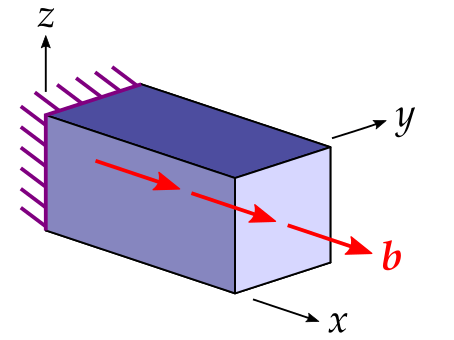Note
Go to the end to download the full example code.
Plasticity with Isotropic Hardening#
The normal plastic strain due to a body force applied on a solid with a linear-elastic plastic material formulation with isotropic hardening with young’s modulus \(E=210000\), poisson ratio \(\nu=0.3\), isotropic hardening modulus \(K=1000\), yield stress \(\sigma_y=355\), length \(L=3\) and cross section area \(A=1\) is to be evaluated.

First, let’s create a meshed cube out of hexahedron cells with n=(16, 6, 6) points
per axis. A three-dimensional vector-valued displacement field is initiated on the
numeric region.
import numpy as np
import felupe as fem
mesh = fem.Cube(b=(3, 1, 1), n=(16, 6, 6))
region = fem.RegionHexahedron(mesh)
displacement = fem.Field(region, dim=3)
field = fem.FieldContainer([displacement])
A fixed boundary condition is applied at \(x=0\).
boundaries = {"fixed": fem.dof.Boundary(displacement, fx=0)}
The material behaviour is defined through a built-in isotropic linear-elastic plastic material formulation with isotropic hardening.
umat = fem.LinearElasticPlasticIsotropicHardening(E=2.1e5, nu=0.3, sy=355, K=1e3)
solid = fem.SolidBody(umat, field)
The body force is created on the field of the solid body.
bodyforce = fem.SolidBodyGravity(field)
b = fem.math.linsteps([0, 200], num=10, axis=0, axes=3)
Inside a Newton-Rhapson procedure, the vectors and matrices are assembled for the given items and the boundary conditions are incorporated into the equilibrium equations.
step = fem.Step(items=[solid, bodyforce], ramp={bodyforce: b}, boundaries=boundaries)
job = fem.Job(steps=[step]).evaluate()
A view on the field-container shows the deformed mesh and the normal plastic strain in direction \(x\) due to the applied body force. The vector of all state variables, stored as a result in the solid body object, are splitted into separate variables. The plastic strain is stored as the second state variable. The mean-per-cell value of the plastic strain in direction \(x\) is exported to the view.
def plot(solid, field):
"Visualize the final Normal Plastic Strain in direction X."
plastic_strain = np.split(solid.results.statevars, umat.statevars_offsets)[1]
view = fem.View(field, cell_data={"Plastic Strain": plastic_strain.mean(-2).T})
return view.plot("Plastic Strain", component=0, show_undeformed=False)
plot(solid, field).show()

Total running time of the script: (0 minutes 2.901 seconds)